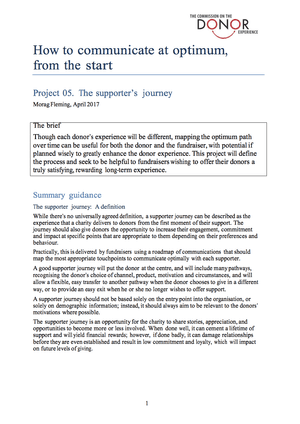CDE project 5 section 3: case study on Practial Action
- Written by
- The Commission on the Donor Experience
- Added
- April 26, 2017
Practical Action Case Study
Introducing a non-ask piece in the welcome journey for cash supporters.
Background
All new individual donors enter a welcome cycle when they donate to Practical Action. Their journey depends on their initial gift type, their recruitment channel and their gift amount.
Within a broad range of work, and multiple acquisition subjects running, a cash donor responding to a specific appeal might then receive a pack about something completely different. This could come across as confusing and irrelevant - for example, a donor could respond to a campaign about water sanitation, and then receive a next ask about food shortages with no link between the two areas of work or reference to what motivated the donor to give in the first place.
Whilst this was recognised as an issue, resource limitations did not allow for there to be a journey for these lower value donors that would tailor the second ask pack to the subject of every acquisition piece.
Practical Action had research-based evidence to say that their donors were generally of a higher educational level than was the average population; therefore, it was decided to try to understand if trying to educate and expand on the detailed technology and the impact of their work at an early point in the journey quickly would improve the donor experience. It was hoped that this would consequently improve the relevance of the next appeal ask and therefore also improve financial results.
The Test
In 2015, Practical Action undertook a three month, 1,000 new donor split-test in the cash welcome cycle. The test included all new donors who gave a first cash gift through on- and off-line channels, and who donated less than £1000.
It was decided to produce a one-size-fits-all ‘light touch’ introductory version of the donor magazine, Small World. Articles were chosen to highlight some of the most successful and impactful campaigns across the entire mix of project work. All articles were re-written to assume no prior knowledge of the charity, and a smaller A5 format was chosen because it would be easier to ‘get into’ than the bigger A4 magazine. Information sections that introduced the supporter care team were included to encourage new donors to feel welcomed and valued.
The test was a simple straight split that included two segments (magazine or no magazine). A donor was either in group A or group B – if in group B, the mini version of the supporter magazine was mailed to donors two weeks after their first cash gift thank-you letter.
A - No Magazine Control Group: Cash gift - within a week, a thank-you letter, four weeks after the thank-you letter a cash ask pack, four weeks after cash ask pack, a regular giving ask pack.
B - Magazine Test Group: Cash gift - within a week, thank-you letter, two weeks after the thank-you letter a mini supporter magazine, four weeks after the supporter magazine a cash ask pack, four weeks after the cash ask pack regular giving ask pack.
Results
Anecdotal results from the supporter care team were positive. Whilst no actual conversations were recorded, feedback was positive and a higher number of non-financial interactions were noticed from the group that had received the magazine than from the group that did not.
The results were quite conclusive. Including feedback quickly to donors on how their donation would make a difference increased the likelihood of them donating again.
The second gift cash appeal saw a significant increase in the response rate from 2.99% (no magazine) to 11.11% (with magazine). The regular giving ask pack also saw an increase from 1.19% to 2.78% in monthly pledges.
Conclusion:
Including a non-ask piece that introduced the work that the charity performed increased the next engagement significantly; therefore, based on this and on anecdotal evidence, Practical Action can assume that this will certainly have improved the supporter’s experience.























